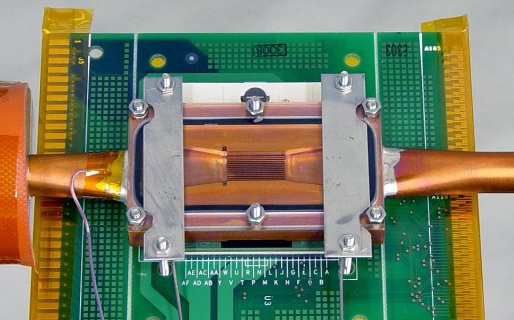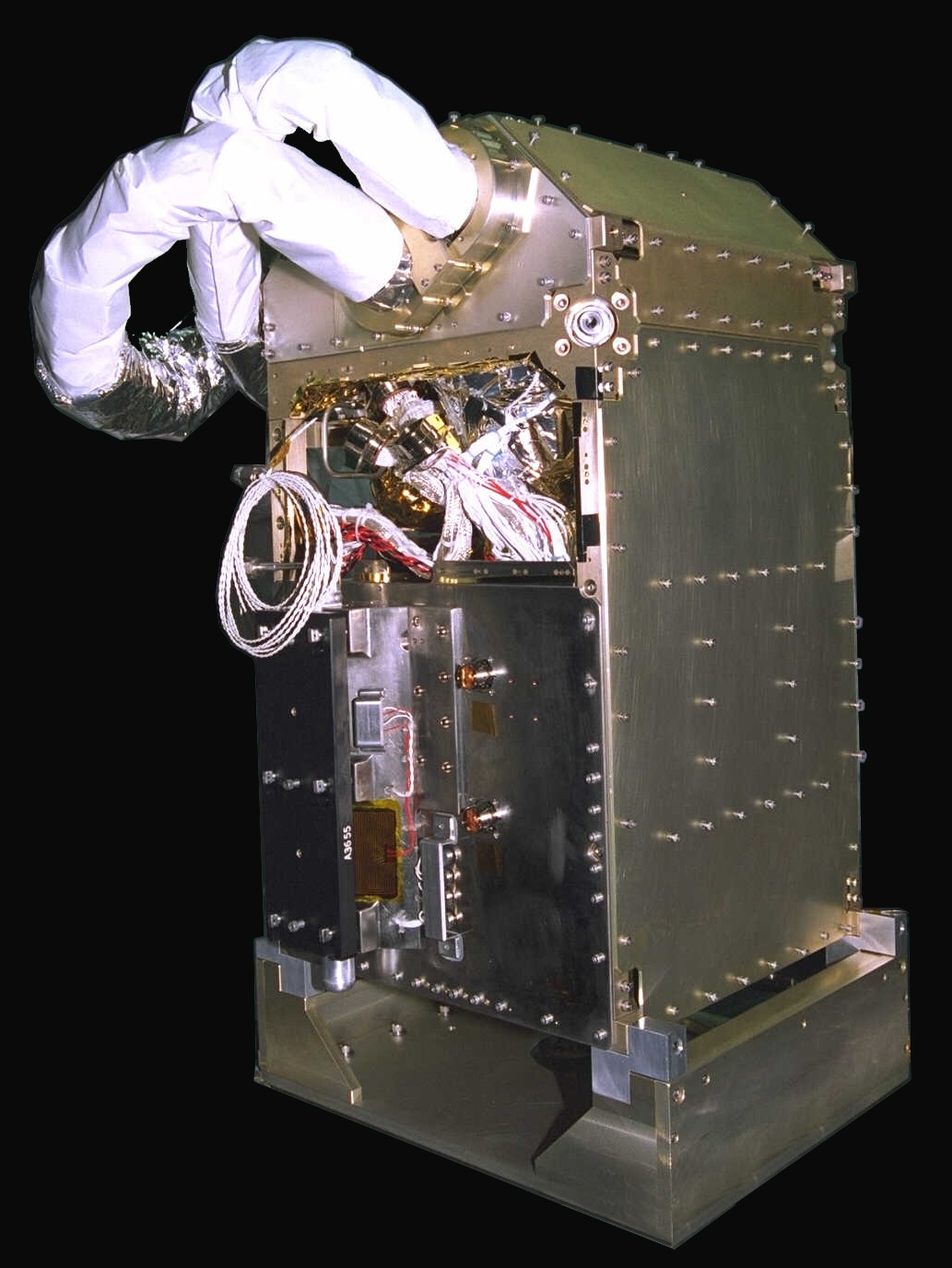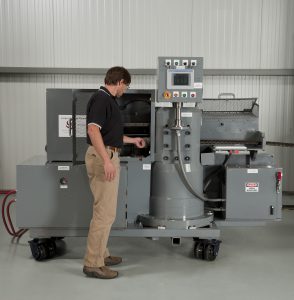Creare works to resolve difficult issues in product design, performance and manufacturing to enable our clients to reach their goals for technical performance, production speed, and cost. Projects have ranged from a day to a decade in length, with funding from a few thousand dollars to $15M.
Please note: to protect the confidential nature of these projects, we generally cannot reveal the customer name or specific details about the work.

Microchannel evaporator for high-power microprocessors.
Electronics Cooling – we evaluated a wide range of advanced concepts for electronics cooling. One project involved the development of a small scale vapor-cycle refrigeration system for a notebook computer. The cold plate and condenser use microchannels to efficiently transfer heat with the refrigerant. Creare designed and fabricated the microchannel heat exchangers and was responsible for assembling the system components to produce the world’s smallest vapor cycle refrigeration system. The refrigerator met all technical objectives for cooling performance and efficiency. In another project, we designed and demonstrated single-phase and two-phase pumped loop concepts for cooling, again utilizing microchannel heat exchangers. The client used results from these tests to assess trade-offs between single- and two-phase cooling systems for microprocessors.
Thermal Management – we assisted the client in developing a thermal management strategy for a power electronic module that will be used in a challenging military vehicle environment. Finite element analysis (FEA) of the heat transfer phenomena was used to evaluate a baseline design as well as designs which took advantage of several improvements.
Consumer Products – we helped the customer to design and prototype a new hand dryer. Our contributions included the evaluation of motor options, initial design of an impeller for the blower, and creation of conceptual drawings for the dryer concept. A prototype device was fabricated, and we performed head/flow performance characterization tests and measured the generated noise. Design improvements were developed based on the test results.
Renewable Energy Systems – Creare developed analysis and design methods for a novel hydrokinetic power conversion system. We devised innovative approaches for modelling system performance with computational fluid dynamics (CFD). We also produced a mechanical design for the system and estimated overall energy conversion efficiency and cost. The analysis and design show that the system has the potential to generate electric power at very good efficiency. We built a subscale flow model of the device and measured its performance in a 100-meter tow tank. Data from these tests validated the system’s potential for achieving high fluid dynamic efficiency.
Semiconductor Manufacturing – Creare helped a manufacturer of semiconductor wet-etching equipment understand flow patterns in their etching chambers. We recommended simple hardware modifications to ensure more uniform flow and improve the etching results. The client adopted Creare’s recommendations, modified the etching chambers in subsequent products, and achieved their goal of improved etch uniformity.
Biopharmaceutical Production – For a maker of healthcare and laboratory products, Creare performed a series of projects over multiple years to help expand production and increase quality yield. In these projects, we applied CFD, used a range of first-principles analyses, and reviewed production data in order to recommend modifications in equipment and operational procedures that boosted the productivity of manufacturing facilities. This work included assistance in design of new production lines as well as optimization of existing equipment.
Turbomolecular Drag Pump – Creare supplied a miniature 200,000 RPM turbomolecular/molecular drag pump to enable rapid evacuation of a sample volume during a rocket launch. The vacuum pump is based on the design that Creare developed for NASA during an SBIR Phase II project. The vacuum pump is the world’s smallest.

Intranasal nebulizer uses a patented disposable drug cartridge.
Aerosol Drug Delivery – We developed technology that provides extremely high delivery efficiency and isolates in a disposable part the device components that contact either the drug or patient. Such technology can yield an optimal platform for vaccination as well as delivery of other therapeutics. On behalf of our customer, Creare successfully obtained FDA 510(k) clearance in 2006 for an initial product.
Compressed Air Energy Storage – We worked with the customer to develop a novel pressurized air energy storage system for peak power shaving and intermittent renewable energy sources. Creare developed novel heat exchange technology that optimized the overall cycle performance.

The NICMOS cryocooler packaged for installation on the Hubble Space Telescope.
In early 1997, NASA approached Creare with an urgent need to develop a vibration-free, long-life mechanical cryocooler to replace the original cooling system for the Near Infrared Camera and Multi-Object Spectrometer (NICMOS) on the Hubble Space Telescope (HST). The instrument had been cooled by a block of solid nitrogen that had depleted, and a replacement cooling system had to be developed and space qualified in time for the scheduled servicing mission to the HST. After an accelerated development process, Creare’s cryocooler was flight qualified during an 11 day mission aboard the space shuttle Discovery in October 1998.
In March 2002, the cryocooler and cryogenic circulator loop developed by Creare were installed on the HST. Within six weeks of its installation, Creare’s cryocooler had returned the NICMOS detectors to operational temperatures (~75 K), and the first images generated by the renewed device were obtained shortly thereafter. Countless scientific discoveries have been attributed to NICMOS including the observations that led to the 2011 Nobel Prize in Physics confirming Einstein’s dark energy. The cooling system continued to operate almost continuously for another 6.5 years. NICMOS and its Creare-built cryocooler have been inactive and in a dormant state since September 2008.
Miniature high-speed turbomachines using gas bearings are a key feature in Creare’s turbo-Brayton cryocoolers. Rotors of 2 to 10 mm diameter rotate at speeds of between 1,000 and 10,000 rev/s on a film of gas to provide long-life operation without wear or vibration. High precision balancing of the low-mass rotors eliminates vibration, and non-contact operation eliminates wear and debris generation. These features were critical factors in NASA’s decision to select Creare’s technology for NICMOS.

Creare’s Compact Swaging Machine for aircraft carrier purchase cables
Creare has developed a compact swaging machine (CSM) to replace the current speltering process used on aircraft carriers to attach terminals to arresting-gear purchase cables. The CSM is much smaller and lighter weight than existing swaging machines, enabling its use in the shipboard environment. The CSM and new purchase cable swaging process will improve operability of the aircraft carrier, reduce operational costs, and improve the quality of life for Navy personnel. The Naval Air Systems Command estimates that this machine will reduce V-2 workload requirements by up to 500 man-hours per deployment, earning this technology the label of “the single biggest Quality of Life improvement in 20 years of V-2.” (V-2 is the division tasked with the responsibility to safely launch and recover aircraft on the flight deck.)
Related link: http://www.navysbir.com/docs/Creare1.pdf